Fantastic Universe, September 1959: A Retro-Review
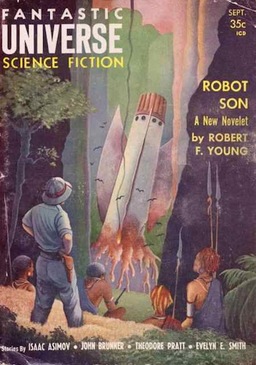 Here is probably one of the less-remembered digest SF magazines of the 1950s. Fantastic Universe was founded in 1953 and lasted until 1960, publishing 71 issues overall… it was a bimonthly briefly then a monthly until its demise (with a missed issue or two along the way). Thus it survived the collapse of the pulps in about 1955, and the American News Company disaster in 1957 or so, and even Sputnik. That’s not a bad run, all things considered.
Here is probably one of the less-remembered digest SF magazines of the 1950s. Fantastic Universe was founded in 1953 and lasted until 1960, publishing 71 issues overall… it was a bimonthly briefly then a monthly until its demise (with a missed issue or two along the way). Thus it survived the collapse of the pulps in about 1955, and the American News Company disaster in 1957 or so, and even Sputnik. That’s not a bad run, all things considered.
But what does historian of the field Mike Ashley say of it (in Tymn/Ashley, Science Fiction, Fantasy, and Weird Fiction Magazines):
Fantastic Universe was born at the height of the SF magazine boom in 1953, and perhaps the most surprising fact about it was that it survived the boom and appeared regularly throughout the rest of the 1950s. Because if FU had any distinguishing feature it was its remarkable lack of memorable or meritorious fiction.
Ouch!
Alas, a skim through the TOCs of its run supports that notion: the most memorable stories were perhaps “Short in the Chest,” by “Idris Seabright” (Margaret St. Clair); “The Large Ant,” by Howard Fast; “Be My Guest,” by Damon Knight; and Robert Silverberg’s “Road to Nightfall.”
Add a couple of stories more famous for either their novel expansion, or the movie version: Algis Budrys’ “Who?” and Philip K. Dick’s “Minority Report,” and a couple decent but minor stories each by Poul Anderson and Jack Vance, oh, and say Walter Miller’s “The Hoofer” and Avram Davidson’s “The Bounty Hunter.” There was a short Borges story in translation as well (before Borges was all that well known in the US). Not all that much to show for 71 issues: even these stories I mention are solid works but not their authors at their very best.
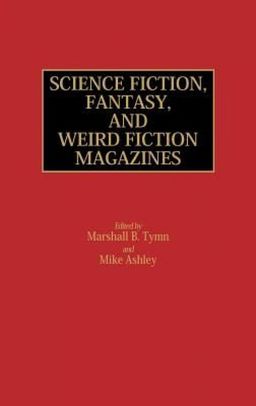 The publisher was King-Size Publications for most of its run. The first editor was Sam Merwin, who did some fine work at Startling Stories and Thrilling Wonder Stories; he was followed by Beatrice Jones, Leo Margulies, and finally Hans Stefan Santesson, the editor most associated with the magazine.
The publisher was King-Size Publications for most of its run. The first editor was Sam Merwin, who did some fine work at Startling Stories and Thrilling Wonder Stories; he was followed by Beatrice Jones, Leo Margulies, and finally Hans Stefan Santesson, the editor most associated with the magazine.
The overall approach of the magazine was as a sort of downmarket version of F&SF. Fantastic Universe published a similar mixture of SF and Fantasy, particularly the rather coy sort of fantasy F&SF featured a lot of in the ’50s. Like F&SF, Fantastic Universe liked to get stories from writers outside the field.
I had a beat up issue from late in the magazine’s run, September 1959, and I figured I’d give it a try. The cover is indifferent work, by Richard Carlson, showing a spaceship crashed in a forest, the witnesses some natives and a “great white hunter” sort. There is a curious description of the cover painting on the inside front cover, suggesting that the crash happened on Venus, the natives are Venusians, and the “great white hunter” is a failed District Officer. Seemed pointless to me.
There are two features, a science article (“Music for the Space Age,” by Stephen Lloyd Carr, which advocates a continued focus on music education even with the expanded focus, post-Sputnik, on science [I have to say I agree with his points]), and a book review column, The Universe in Books, by Santesson, which has a number of capsule book reviews and then some fannish news. (The Miller-Contento index suggests that the fannish news part is derived from an article by Frank Dietz that had appeared in the fanzine Peals in May 1959.)
Here are the stories:
“Rain, Rain, Go Away,” by Isaac Asimov (2,600 words)
“The Round Trip,” by John Brunner (2,900 words)
“The Dancing That We Did,” by Myrle Benedict (4,700 words)
“The Alternate Host,” by Evelyn E. Smith (3,800 words)
“Robot Son,” by Robert F. Young (12,000 words)
“Deborah and the Djinn,” by Lucy Cores (5,000 words)
“Beanpeas in the Afternoon,” by David C. Knight (2,000 words)
“The Woodcutter’s Tale,” by Edd Doerr (1,500 words)
“Doorway to Heaven,” by Theodore Pratt (4,500 words)
“The Red Hot Deal,” by Joseph Farrell (3,000 words)
“The Outbreeders,” by Calvin M. Knox (4,500 words)
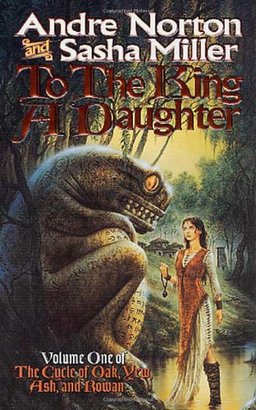 At this stage of his career Isaac Asimov could be kind of annoying – he wrote some really slapdash stuff (in amongst some excellent work, to be sure). He had a deal with various editors of lower-end magazines whereby he would offer them a new story. If they wanted to pay the same rate the top-end magazines paid, they could have the story. If not, he’d send it to the top magazines, and if they took it fine. If not, Asimov would give the story to the lower-end magazine.
At this stage of his career Isaac Asimov could be kind of annoying – he wrote some really slapdash stuff (in amongst some excellent work, to be sure). He had a deal with various editors of lower-end magazines whereby he would offer them a new story. If they wanted to pay the same rate the top-end magazines paid, they could have the story. If not, he’d send it to the top magazines, and if they took it fine. If not, Asimov would give the story to the lower-end magazine.
I don’t know if this deal applied with Fantastic Universe, but if it did, I’m fairly sure “Rain, Rain, Go Away” was a story they got at their rate, not Asimov’s. (Actually Wikipedia says the idea for the story came from F&SF editor Robert P. Mills, but that he rejected it, not surprisingly.) It’s about an odd family of “foreigners” who seem terribly afraid of rain. The neighbors insist on getting to know them better, including an outing on what seems a very nice day… but an unexpected rainstorm comes up. I won’t give the ending away, but it’s really trivial. Asimov at pretty much his worst.
“The Round Trip” is a somewhat illogical John Brunner story turning on a somewhat familiar idea. It’s written as a letter from a spaceship commander to his wife, telling her they will never meet again… Why? Somehow the mission his is leading has come to the exact center of the universe, and somehow they will end up participating in the next cycle of the universe’s existence… so that, when he and his wife meet again, they will actually be different people: their next avatars, or something. The idea is kind of cool, but I kept being pulled out of the story by slightly illogical aspects. I suspect the fault here is mine more than Brunner’s, actually.
Myrle Benedict, author of “The Dancing That We Did,” is an interesting case. Her real name is Georgia Myrle Miller. She was born in 1933 and is still alive. She lives in Oklahoma, apparently has for her entire life. She sold three stories (all related, I assume) to Fantastic Universe in the late ’50s, published as by “Myrle Benedict.” (Her husband’s name is Ben … I wonder if “Myrle Benedict” is a combination of her maiden name and her husband’s first name.) After a decade of silence she published three historical novels as by “Georgia Sallaska.” Then after another period of silence she began publishing under the name Sasha Miller, often in collaboration with Andre Norton. Just last year she published a fantasy trilogy, The Wayenor Saga (with FoxAcre, a Print-On-Demand outfit, I believe, but one with some credibility). That’s a pretty intriguing career shape, to me.
As for “The Dancing That We Did,” I thought it pretty enjoyable. It’s about a young man coming home from college to his rural home. He attends a square dance, and connects with a young woman he’s known his whole life but never really thought of “that way.” The story is surprisingly frank for its time… they clearly have sex in the open after leaving the dance, and there are quite complete descriptions of her body… nothing unusual these days, but, I would have thought, a bit daring in 1959. The fantastic element is that both of these young people are apparently a different species… cat people, it seems. It’s a pretty fair little piece.
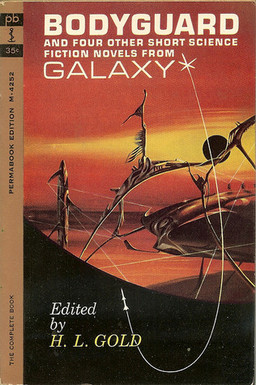 Evelyn E. Smith (1922-2000) was a quite prominent 1950s writer, mostly associated with Galaxy. She appeared regularly in Galaxy between 1952 and 1961. (Including, some sources say, three Galaxy novellas as by “Christopher Grimm” (one at least of which, “Bodyguard,” is quite good)… but now I see that other sources say editor H. L. Gold was “Grimm” … this remains an unresolved mystery.) After that she published only a few stories in F&SF in the ’60s, and also a few novels into the ’70s. In the ’80s she turned to writing mysteries, with some success. I tend to enjoy her stories. “The Alternate Host” is about humans coming to an alien planet. The narrator is a native, who is unable to warn the humans from being tempted by the mysterious and dangerous “Belanai.” The nature of the Belanai and of the more benevolent alien narrator isn’t much of a surprise… but it’s not a bad slight little thing.
Evelyn E. Smith (1922-2000) was a quite prominent 1950s writer, mostly associated with Galaxy. She appeared regularly in Galaxy between 1952 and 1961. (Including, some sources say, three Galaxy novellas as by “Christopher Grimm” (one at least of which, “Bodyguard,” is quite good)… but now I see that other sources say editor H. L. Gold was “Grimm” … this remains an unresolved mystery.) After that she published only a few stories in F&SF in the ’60s, and also a few novels into the ’70s. In the ’80s she turned to writing mysteries, with some success. I tend to enjoy her stories. “The Alternate Host” is about humans coming to an alien planet. The narrator is a native, who is unable to warn the humans from being tempted by the mysterious and dangerous “Belanai.” The nature of the Belanai and of the more benevolent alien narrator isn’t much of a surprise… but it’s not a bad slight little thing.
Robert F. Young’s “Robot Son” is probably the story in this issue that annoyed me the most. It’s set in a future where humans lives sterile lives of comfort, all their needs provided by machines. But suddenly the machines malfunction… for example, winter comes! One “Lathehand”decides to visit the “Tekgod” to find out why he is betraying the people, and he encounters one of the god’s virgin servants on the way. They join together, and are captured by a “prophet” of the Tekgod, who insists that the people must return to obedience… The lame trick here is revealed when we learn the virgin’s name: Mary; and also the first name of “Lathehand” (or, “Carpenter”): Joseph. For me, Young has always been a decidedly uneven writer: overrated for his prose, which when he tried was merely purple (when he didn’t try, as here, it was simply bland); but occasionally (not in this case) capable of moving and interesting plots.
Lucy Cores (1912-2003) is an example of just the sort of writer F&SF often featured in that period: not an SF writer at all, she had a mild reputation for her mysteries, romance novels, and historical fiction. She was a native of Russia, moving to the US at the age of 9. She was close friends with Willy Ley’s ballerina wife, Tina, who may have been the inspiration for the heroine of her mysteries. She lived on Martha’s Vineyard, and not surprisingly the story here, “Deborah and the Djinn,” is set on that island. Deborah is a handsome single woman of a certain age, quite resistant to the overtures of any of the local men. One day she buys a used lamp at a sale, and of course when she cleans it a djinn appears. But Deborah is more interested in feeding the djinn and showing him a good time than in any wishes… A nice if predictable story.
David C. Knight was an editor who published three stories in the field, all in Fantastic Universe. He is probably the same editor who compiled a collection of ghost stories in the 1980s, and the author of a number of books about space colonies and other space-related subjects. “Beanpeas in the Afternoon” is a somewhat silly story about a colony on another planet. The colonists came on a generation ship, but a backup set came along in suspended animation. After a plague, it became necessary to revive the backups as replacement husbands and wives… and one man finds out, a few years later, that his new wife was the mother of one of the original passengers on the ship… his own ancestor! It’s hardly incest after several generations, but we are, I guess, supposed to be shocked.
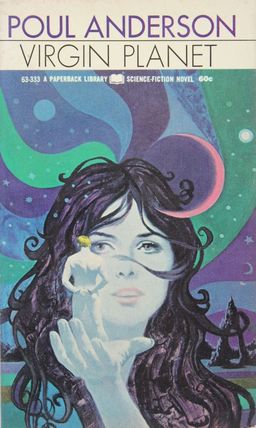 Edd Doerr is another of the sort of dilettantish writer F&SF (and, in imitation perhaps, Fantastic Universe) would sometimes publish. He is described as “a teacher and social worker… Associate Editor of The American Rationalist… published in… The Liberal, the Independent, and Progressive World.” I imagine he’s the same Edd Doerr who was (is still?) a prominent Unitarian, and President of the American Humanist Association and Americans for Religious Liberty. (He also served as Vice President of the AHA while the President was Isaac Asimov, for the last six years of Asimov’s life.) “The Woodcutter’s Tale” is a cautionary story about time travel: a woman journeys into the medieval past, and the woodcutter who meets her assumes she’s a demon, and takes measures. Very minor stuff.
Edd Doerr is another of the sort of dilettantish writer F&SF (and, in imitation perhaps, Fantastic Universe) would sometimes publish. He is described as “a teacher and social worker… Associate Editor of The American Rationalist… published in… The Liberal, the Independent, and Progressive World.” I imagine he’s the same Edd Doerr who was (is still?) a prominent Unitarian, and President of the American Humanist Association and Americans for Religious Liberty. (He also served as Vice President of the AHA while the President was Isaac Asimov, for the last six years of Asimov’s life.) “The Woodcutter’s Tale” is a cautionary story about time travel: a woman journeys into the medieval past, and the woodcutter who meets her assumes she’s a demon, and takes measures. Very minor stuff.
Theodore Pratt (1901-1969) is another writer who had a reputation outside the genre. He wrote for the New York Sun and the New Yorker, and wrote a number of novels set in Florida, several of which became films, perhaps most famously Mr. Limpet, which was filmed as The Incredible Mr. Limpet, starring the annoying Don Knotts, in 1964. I remember seeing it on TV as a child, and being annoyed even then. Pratt’s fantastical work was almost exclusively for Fantastic Universe… he published several stories there. “Doorway to Heaven” suggests an alternate sort of afterlife, in which you can call up anyone you like… but if you do, you can reject them, which gives our hero, a henpecked husband, considerable power over his overbearing wife. I wasn’t convinced.
Joseph Farrell published 16 stories in the SF magazines between 1943 and 1959. “The Red Hot Deal” seems to have been his last. It’s about a couple of aliens who pose as a magician and a devil (one of them looks like a cliché devil) in order to scam a scientist who has turned to alchemy. But he turns the table on them… Trivial stuff.
Finally, we have a story by Robert Silverberg, under his “Protestant” pseudonym, Calvin M. Knox. “The Outbreeders” is pretty solid work. It’s set on a planet where two couples landed after some sort of spaceship accident. Generations later, the descendants of the two couples remain isolated, so that each produces children who are almost like clones. (Unconvincingly, to me, the women all look alike, and the men all look alike – surely there would be women who looked like the men, and vice versa. Also, their would have been a lot of problems with inbreeding.) In this story, a young man of one family encounters a young woman of the other family, and the inevitable happens… they fall in love. I was reminded a bit of Poul Anderson (perhaps just because of the nearly contemporaneous Virgin Planet). It’s not the most plausible story but I quite enjoyed it.
Rich Horton’s last retro-review for us was the June 1951 issue of Galaxy Science Fiction. See all of Rich’s retro-reviews here.